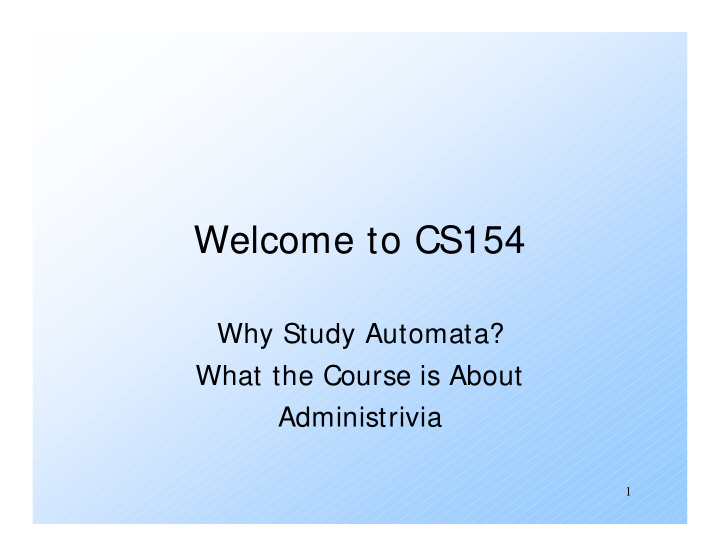



Welcome to CS154 Why Study Automata? What the Course is About Administrivia 1
Why Study Automata? A survey of Stanford grads 5 years out asked which of their courses did they use in their job. Basics like CS106 took the top spots, of course. But among optional courses, CS154 stood remarkably high. 3X the score for AI, for example. 2
How Could That Be? Regular expressions are used in many systems. E.g., UNIX a.* b. E.g., DTD’s describe XML tags with a RE format like person (name, addr, child* ). Finite automata model protocols, electronic circuits. Theory is used in model-checking . 3
How? – (2) Context-free grammars are used to describe the syntax of essentially every programming language. Not to forget their important role in describing natural languages. And DTD’s taken as a whole, are really CFG’s. 4
How? – (3) When developing solutions to real problems, we often confront the limitations of what software can do. Undecidable things – no program whatever can do it. Intractable things – there are programs, but no fast programs. CS154 gives you the tools. 5
Other Good Stuff in CS154 We’ll learn how to deal formally with discrete systems. Proofs: You never really prove a program correct, but you need to be thinking of why a tricky technique really works. We’ll gain experience with abstract models and constructions. Models layered software architectures. 6
Course Outline Regular Languages and their descriptors: Finite automata, nondeterministic finite automata, regular expressions. Algorithms to decide questions about regular languages, e.g., is it empty? Closure properties of regular languages. 7
Course Outline – (2) Context-free languages and their descriptors: Context-free grammars, pushdown automata. Decision and closure properties. 8
Course Outline – (3) Recursive and recursively enumerable languages. Turing machines, decidability of problems. The limit of what can be computed. Intractable problems. Problems that (appear to) require exponential time. NP-completeness and beyond. 9
CS154N If you are taking CS154N, you should start coming to class when we enter the Turing-machine material. 10
Meet the TA’s Shrey Gupta Rohan Jain Jia Li 11
Course Requirements Two kinds of homework: 1. Gradiance homework (automated, straightforward, 20%). 2. Challenge problems (conventional written work, harder, 20%). Two exams: Midterm (20%). Final (Monday June 7, 7-10PM, 40%). 12
Text Hopcroft, Motwani, Ullman, Automata Theory, Languages, and Computation 3 rd Edition. Course covers essentially the entire book. 13
Gradiance Registration The “class token” for this edition of CS154 is 1DC79FE7 . Register it at www.gradiance.com/pearson Texts come with free access cards. Go to www.aw-bc.com/gradiance to purchase or register (link at upper left). 14
Comments About Gradiance Homework The intent is that everyone will get 100% on all homeworks. You are allowed to try as many times as you like. Only the last try counts. Don’t be afraid to guess and try again. You’ll get some advice if you make a mistake. 15
Recommend
More recommend